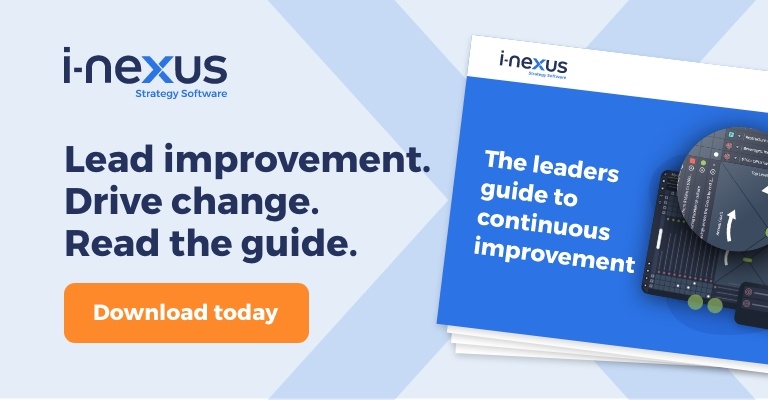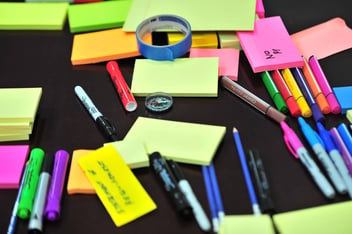Continuous improvement, or Kaizen, is a method for identifying opportunities for streamlining work and reducing waste. In this blog, we cover the topic of what it is.
The continuous improvement methodology, or Kaizen, is a business approach whereby your organization strives to better your processes.
Historically, the concept was applied to manufacturing, with its goal to eliminate waste (at the time, this was raw materials and labor) so the end product could be shipped faster and cheaper.
Today, continuous improvement refers to knowledge-based environments to remove “waste” or inefficiencies in the workplace to reach a business goal as efficiently as possible.
Here, we’ll explore the continuous improvement methodology, how it coincides with Hoshin Kanri, and its benefits to your business.
What is continuous improvement?
Continuous improvement is the ongoing effort to improve your products, services, or processes by increasing quality or reducing waste.
The methodology has several benefits, including better teamwork and morale, less waste, increased profitability, and stronger customer satisfaction.
To follow this methodology, your business’ processes are constantly evaluated and improved based on their efficiency, effectiveness, and flexibility.
Continuous improvement is also known as Kaizen in the context of Lean management, and is commonly linked to the Deming Cycle - PDCA (Plan, Do, Check, Act).
You may have heard of the concept of Lean management in the business world, which encourages continuously improving work processes, purposes, and people.
Continuous improvement is one of the two main pillars of the Lean methodology. In simple terms, continuous improvement is the strive for perfection in everything you do.
Kaizen origins
Kaizen originated from post-World War II Japan in the manufacturing industry to prevent defects at Toyota.
The term is a compound of two Japanese words that together translate as “good change” or improvement”, Kaizen has evolved to mean continuous improvement.
In today’s world, continuous improvement seeks to improve the processes of your business by enhancing the activities that generate the most value for your customers and removing as much waste as possible.
What are the elements of continuous improvement?
As we’ve explained, continuous improvement involves increasing quality and removing as many waste activities as possible to improve your products, services, and processes.
There are three elements of the continuous improvement methodology to be aware of that also make up the concept of Lean.
Lean was developed around eliminating three types of deviations that are an inefficient use of resources.
These three types, Muda, Mura, and Muri, are stars of the uber-popular "The Toyota Way" book - a must-read for anyone interested in being more efficient and effective at their work.
Muda
While Muda is only one part of the continuous improvement methodology, it is the one that is most often focused on, as it’s fairly straightforward to apply.
In Lean management, Muda is an activity that doesn’t contribute value to your business.
These wasteful activities, actions, or tasks must be reviewed and often removed from the business processes.
But Muda isn’t just a word; it’s also a mindset.
By being mindful of the waste your business produces, your business can then go on to make valuable changes to its processes and achieve its goals.
The Japanese word “Muda” translates to “wasteful” - the opposite of work that adds value. The concept originated in the manufacturing industry to help reduce and eliminate wastefulness to improve efficiency and profitability.
Muda and the Toyota Production System
Muda was a key concept in the Toyota Production System, which stressed the importance of eliminating waste by reducing jobs that can be difficult for an employee.
By doing so, there would be work that required a specific skill set - thus, businesses should hire qualified workers to reduce wastefulness during production, such as defects.
There are two types of Muda for you to explore: type one and type two.
Type one Muda consists of activities that can’t be eliminated straight away, and type two Muda includes activities that can be eliminated quickly through Kaizen.
Muda example
Imagine a company that produces custom-made furniture.
One of their employees spends two hours each day searching for the right tools and materials because the workshop is disorganized and cluttered.
This is an example of Muda because it is a wasteful activity that does not add value to the final product.
The employee could have spent those two hours producing furniture instead of looking for tools and materials, which would have increased productivity and reduced costs.
By eliminating Muda, the company can improve efficiency and deliver better value to its customers.
Mura
Mura refers to unevenness and irregularity in production and services, which drives and leads to Muda.
Often, it’s caused by standards that are either not followed or nonexistent. Irregular working rhythms are also a significant cause of Mura.
Mura describes those “feast and famine” cycles of work, where some periods are hectic, and others are very quiet - leading to frantic work, then periods with not enough to do.
Muda example
If a company ramps up production to meet its targets even when there is no customer demand, this forces a rush to fill orders and leaves the shipping department rushing to finish products by the end of the month.
The result is products having defects, customers receiving inconsistent products or services, the production team struggling to complete large orders, and production slowing down.
Reducing or eliminating Mura can lead to a more consistent workflow and keep Muda and Muri more manageable.
Muri
The final element of the continuous improvement methodology is Muri - a Japanese term meaning “overburden or unreasonable.”
The final type of waste drastically decreases your team’s efficiency.
You create Muri whenever your team is put under stress due to unreasonable or unnecessary tasks that exceed their capacity.
This extra work can cause them to work long hours, leading to occupational burnout.
Muri example
For example, setting a last-minute deadline can force your team to rush the work, leading to poor-quality products or services. In turn, this can damage your reputation and customer satisfaction.
Overburning your employees without realizing you’re doing it can be easy.
This can lead to inefficiency and can also damage your profitability.
To try and avoid Muri, it’s important to encourage clear communication and ensure your team has the proper equipment and tools to do their job as effectively as possible.
What are the benefits of continuous improvement?
Incorporating the continuous improvement methodology into your organization can help your teams operate more efficiently and effectively and help you stand out against competitors.
Several benefits of continuous improvement can help your business compete in today’s competitive landscape:
- Efficiency and productivity
By removing wasteful tasks and improving the consistency of your processes, your teams’ efficiency and productivity will soar. Eliminating unnecessary steps in your production can make your processes more efficient and lead to faster delivery. - Product quality
Continuous improvement aims to make minor improvements to your processes. By reducing waste and making these processes more efficient, the quality of your products should improve, which should increase your profit margins.`
- Customer satisfaction
Continuous improvement can offer you better insight into your customers’ needs. By identifying their problems and the services or products that are most valuable to them, you can meet their needs more accurately. - Objectives
Continuous improvement can ensure your employees are aware of your organization’s objectives and work to fulfill them. There will be less waste or roadblocks in how employees achieve these strategies and company goals.
How does continuous improvement fit in with Hoshin Kanri?
Hoshin Kanri, also known as strategy deployment, is essential to the continuous improvement methodology.
Hoshin Kanri roughly translates to “direction management” and is a strategic planning tool that helps your company’s strategic goals drive progress by eliminating the waste that comes from both poor communication and inconsistency. It aims to drive strategy execution through continuous improvement.
Hoshin Kanri aims to get every team member to pull in the same direction at the same time.
This may sound too good to be true, but it can be achievable with the right tactics and planning. Hoshin Kanri requires planning, targeted benchmarking, and the tools for continuous improvement to succeed.
The process is made up of seven steps that aim to develop your company’s strategy:
- Establish organizational vision
Your organizational vision combines your company’s purpose with its values and mission.
The first step of Hoshin Kanri is to establish your vision statement - what are your team’s long-term goals? It’s important to assess your current mission and what is and isn’t working.
Visualize how each individual’s work affects your organization’s long-term goal and overall vision. - Develop strategic/breakthrough objectives
These are the changes your organization needs to make to achieve the vision you decided on in step one. Try not to set too many objectives - instead, you should aim for three or four long-term objectives that should take three to five years to achieve. - Develop annual objectives
Next, decide on the annual goals you want your business or team to achieve. With strategic goals taking a few years to achieve, breaking them into smaller, short-term goals should feel more manageable and realistic.
Decide on the number of goals you’d like to achieve within the next year - anywhere from two to ten is a good number. Make sure these annual goals are SMART - specific, measurable, achievable, realistic, and time-bound.
Remember to track your team’s progress with these goals and decide on a success metric that you can use as a KPI (key performance indicator) for each objective. - Deploy annual objectives
You then need to break down your annual goals into smaller tasks. To do so, you’ll need to segment your yearly objectives into actionable tasks specific to each team or department of your organization.
This should help your team understand the big goal (your annual objectives) and the smaller goals they’ll work towards to hit these more significant milestones. - Implement annual objectives
Now that you’ve split your annual objectives into smaller goals, each of your teams should have different, individual strategies.
The way you choose to implement these is your choice. For example, you could do this through the continuous improvement method (Kaizen).
Once you get started, you can gather feedback on what is working well and what needs changing to achieve your goals. - Monthly reviews
Monthly reviews are vital to ensure you check in on your goals and the work to achieve them. Hoshin Kanri makes this straightforward.
Once you begin your yearly objectives, the results will make their way to your leadership team. You can use their feedback to look at how you’re making progress.
What’s going well? What do you need to improve on? - Annual review
The final step of Hoshin Kanri brings it all together. Once you’ve completed a year’s progress, you must review everything your team has achieved.
Did you meet your goals? If not, what can you do differently next time?
Once you’ve worked out what needs improvement, you can begin the process again from the beginning to address any roadblocks and have a second shot at achieving your goals.
Integrate Hoshin Kanri and continuous improvement with i-nexus
Hoshin Kanri allows your organization's strategic goals to be easily communicated and actioned.
Investing in a strategy execution framework like Hoshin Kanri can help your business to achieve its short-term and long-term goals, integrate a continuous improvement mindset into its operations, and ensure that progress is regularly reviewed.
Find out more about Hoshin Kanri today.
Learn more about Hoshin Kanri and continuous improvement
Take the next steps in your journey by exploring our Hoshin Kanri resource hub or any of the below:
- The complete Hoshin Kanri Excel template pack: Download our x-matrix, bowling chart, action plan, and root cause analysis Excel template and PDF guide pack.
- Hoshin Kanri - OGSM - OKR: a case of apples and oranges?: Uncover the similarities between Hoshin Kanri, OGSM, and OKR in our comparison eBook.
- Digitalize your x-matrix: We all know the shortcomings of x-matrix Excel sheets, but how can you break through and achieve a true step-change in your Hoshin planning and execution? Enter the i-nexus x-matrix and this 30-minute webinar.
About the author
James Milsom is Head of Marketing at i-nexus. James has wide-ranging experience in telecommunications, energy, education, and software markets.
As Head of Marketing, he aims to raise awareness and understanding of enterprises' challenges in delivering strategic objectives and transformation amidst changing markets and the obstacles traditional tools and methods present leaders.
If you’d like to talk more about strategy execution, contact James at james.milsom@i-nexus.com or connect with him on LinkedIn for the latest insights.




